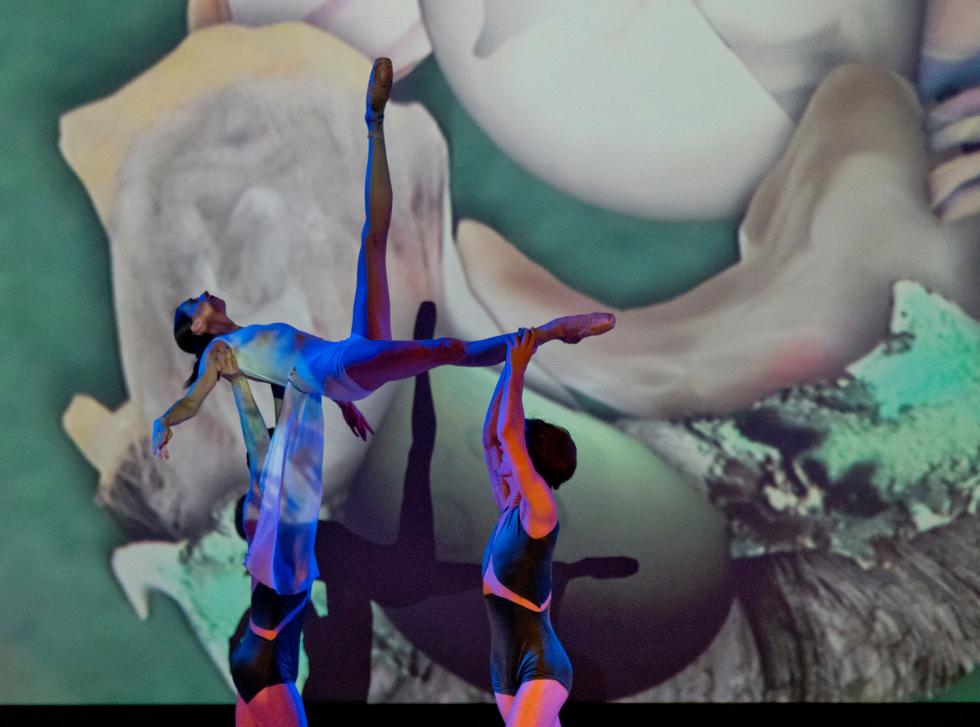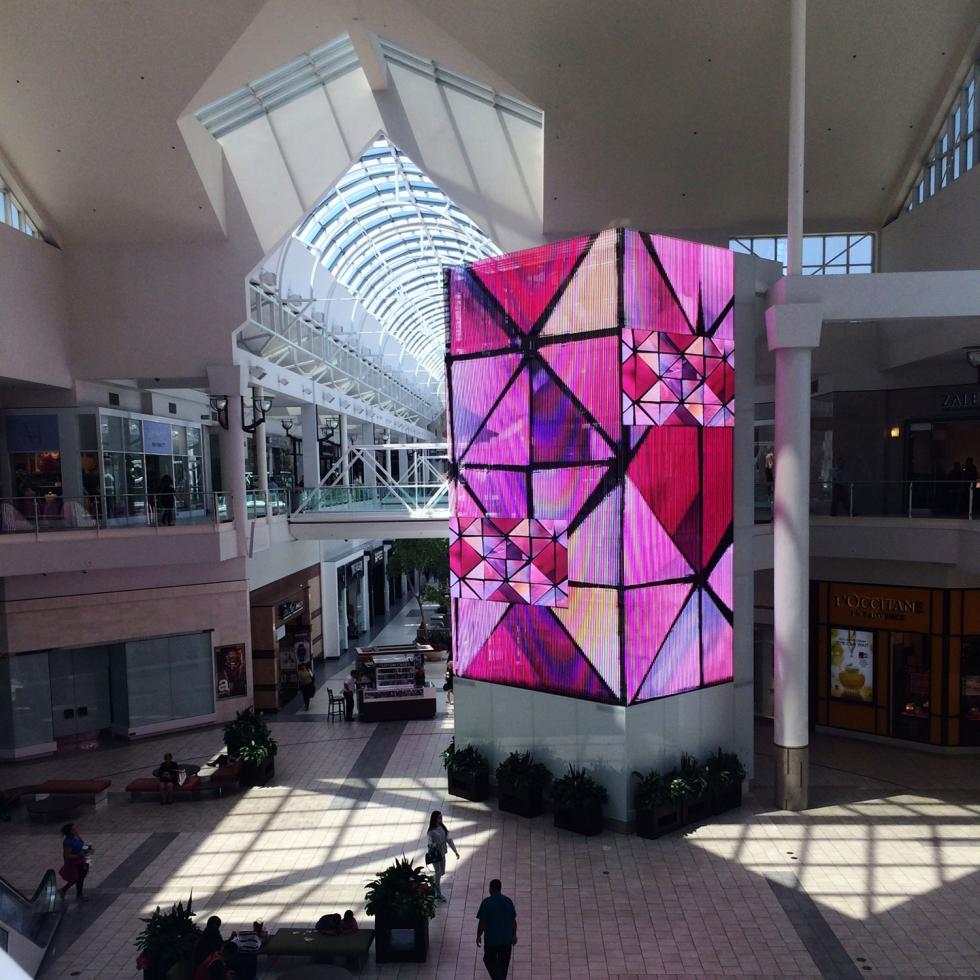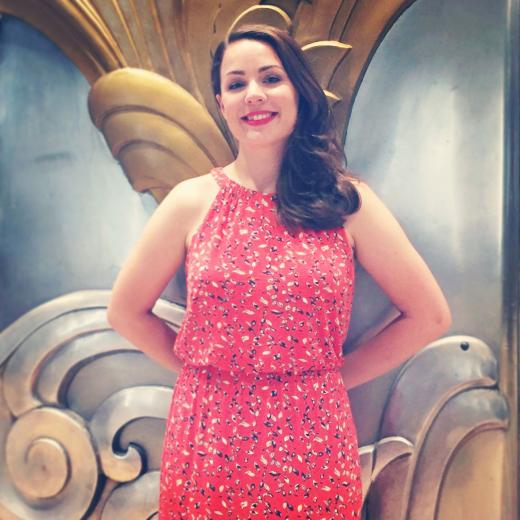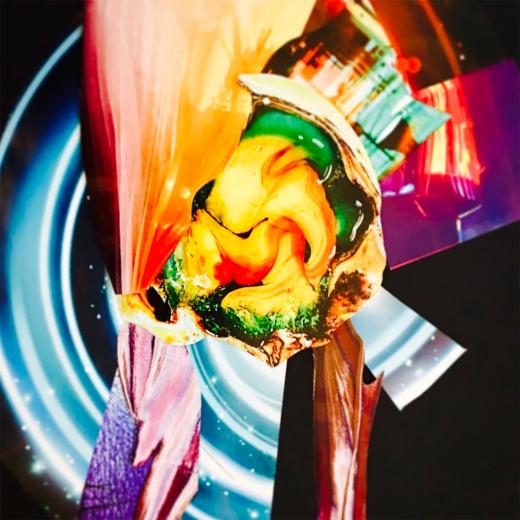Under the Did You Know? section of Natalie McKeever’s IMDb page, it says her sign is Sagittarius. “I’m obsessed with films and movies, so it was a dream come true to get an IMDb credit,” she says. McKeever worked as a production assistant several years ago on a handful of independent films and a few TV series, including “Damages,” but the type of film she works on now is much different.
McKeever creates fine-art digital video, abstract and without narrative, with analog collages that are digitally manipulated to put the viewer in a meditative state.
McKeever, who grew up in New Jersey, had wanted to become a director and go to film school, but as a student at Rutgers University, she majored in the video-art program and developed an interest in video art. “You’re using the same tools, but it’s more about concept and atmosphere,” she says.
“The Perpetual,” collaboration with Shania Rasmussen for “Behind
the Barre,” digital animation, 2018. At the Crest Theatre with
dancers: Ava Chatterson, Dylan Keane and Rex Wheeler. (Photo
courtesy Manny Crisostomo)

And McKeever has been finding her own success in Sacramento since her arrival in 2016. She was selected to show her work in several open-call projects, including ArtStreet and Arden Fair’s “Elevate: An Art Exhibition,” both in 2017, and Audio Muse at Crocker Art Museum and Capital Dance Project’s “Behind the Barre” in 2018.
In “Elevate,” her stop-motion animation called “Skylight” was displayed on the mall’s interior 40-foot LED screen during the month. The 30-second looped film consisted of stained-glasslike colored triangles that would progress through different hues of the sky. “It was just [analog] replacement animation, so you’d kind of take one out and replace it with something else, and with frame-by-frame stop-motion, it looks like it’s changing,” McKeever says.
“The Perpetual,” collaboration with Shania Rasmussen for “Behind
the Barre,” digital animation, 2018. Dancers pictured: Ava
Chatterson, Dylan Keane and Rex Wheeler. Photo courtesy Natalie
McKeever)

Family is what brought you to Sacramento. How do you feel about it here so far?
I love it so far. It’s been really accessible to show my art, and then there’s been a lot of venues and showcases where it’s a diverse … really big audience, so it’s not just like showing your stuff at a gallery where it’s the expected people who would like to see the art are going to see art.
How do you find your projects?
There’s been a lot of nice open calls. … Last year, I did two. … One was at the Crocker Art Museum. It was the Audio Muse program, and they pair a musician or a group of musicians with a video or digital-media artist. I didn’t work directly with [the musicians, the Sacto Storytellers], but I was inspired by their music … [and made a video] to show in the background.
“Storyteller Parade,” digital print, 2018. For Audio Muse at the
Crocker Art Museum. (Photo courtesy Natalie McKeever)

Did you like teaching?
I really liked it. … When I moved to Sacramento, I got a job at Southside Art Center — now it’s called Southside Unlimited. It’s a day program with adults with developmental disabilities. … I got to teach film and video and computer art. I taught there for about a year. Right now, I am helping my sister’s business. … I am working with her … [and] retraining as a dancer. I stopped when I was 17, but I’ve come back, and I’ve been retraining and competing again.
Were you surprised you were selected for “Elevate”?
I was surprised, because that was one [for] a huge audience, and the thing I got at the Crocker for Audio Muse was actually because the woman in charge of that had seen the Arden Fair piece. …
ArtStreet was another one that I had a piece in that like everyone in town saw. … Then I did [“Beacon,”] a show that Tre Borden and Jessa Ciel curated. They projected things down on K Street. … Everything I’ve gotten here in Sac to display my art has been a really public, open thing, which has been so great.
“Skylight,” stop-motion animation, 2017. Installed at Arden Fair.
(Photo courtesy Natalie McKeever)

What projects are you working on now?
I’ve been kind of developing like a little bit of a style using analog collage and then digital animation, bringing collages into After Effects, kind of making the forms shift around. … It’s kind of related to my old work, where it’s a kind of hypnotic, unfolding imagery. …
I don’t have any exhibitions on the horizon, but at CLARA, [where I am a member,] they’re starting a community arts network. … That’ll be coming up soon in the summer, and it’ll be a group you can join, and … you get to show your work in the auditorium or throughout the building, so that’ll kind of give me a more regular venue to show artwork.
What are the challenges of being a digital and video artist in this community?
In general, it’s harder to find paid opportunities for digital art because it’s not permanent. … You’re not getting paid to make a mural or something like that. … But I’ve been actually having success with that here just because of a lot of those exhibition opportunities did come with a stipend or pay. … There is a market for digital art to be collected, but it’s just a little bit more rare. … Making prints out of art can be something to do.
How do you get around that?
When I was teaching … [I was] expected to be making art as well and exhibiting. … [With] the CLARA community arts network, because they [will] have a marketplace every month, I’m going to invest in making some prints … something I can keep working on, trying to get my art sold. …
I want to find a way to either make lightbox prints or an acrylic print that can have light behind it.
What are the advantages of your medium?
When I was first starting out, it was easy to send my art to be considered for stuff, cause you’re just sending a DVD or a digital file. … I was able to get a nice international resume from that. … You can have one video piece that can be seen in many ways just by how you exhibit it. So different scales, different venues, it’ll look different each time. And then I really like working in digital because you can really experiment.
Do you think a lot of people take video as a medium for granted?
Yeah, it’s true. You’re looking at digital art and videos on your phone all the time, and even like from the time I started learning about video art [in college] — I started in 2004 — and the iPhone comes out in 2007, everything changes as you’re learning it. Even YouTube coming out really changed what we were working on and the medium because it is just so much more accessible.
Recommended For You
Video Art Installation Coming to Downtown Sacramento
‘Beacon’ aims to light up K Street and foster dialogue
Inspired by current politics and an increased focus on California and its state capital, two Sacramentans are looking to instigate dialogue around a new project coming to downtown.




